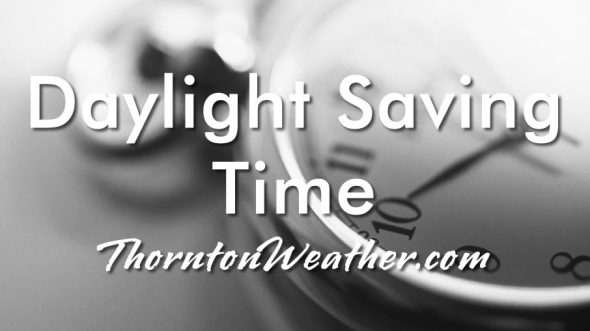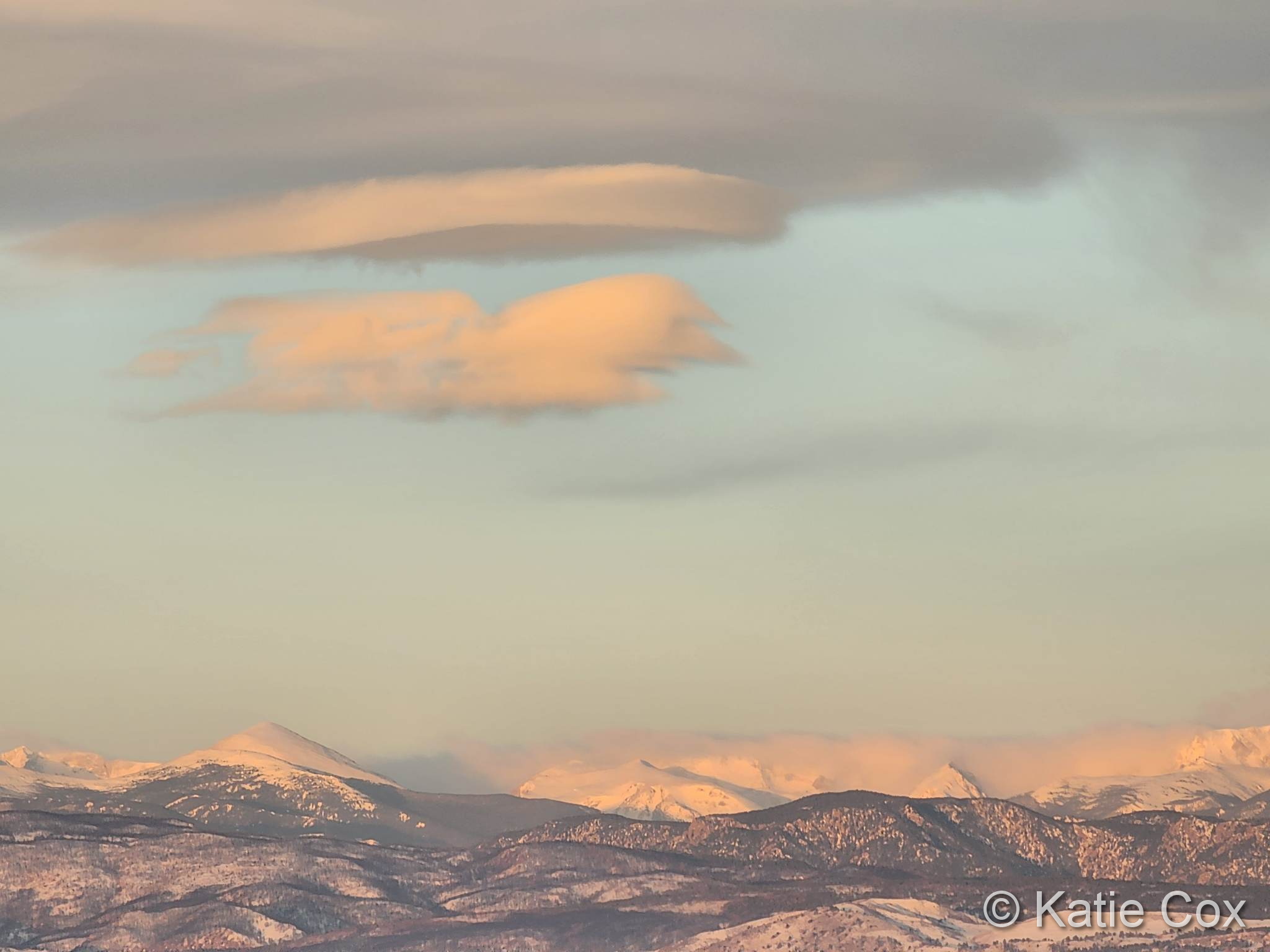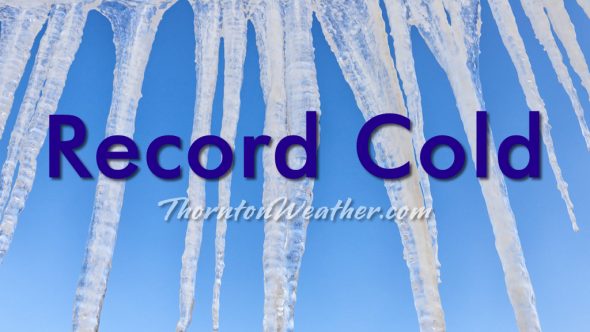
March is Denver’s snowiest month and it is not unusual for us to receive heavy, wet snows during this time. Our look back at this week in Denver weather history highlights many such events.
From the National Weather Service:
3-5
In 1961…snowfall totaled 8.3 inches at Stapleton Airport over the 3-day period with most of the snow…4.4 inches… falling on the 3rd. Winds were generally light gusting to only 23 mph.
4-5
In 1971…heavy post-frontal snowfall totaled 7.7 inches at Stapleton International Airport where north winds gusted to 28 mph.
In 1992…snow spread from the mountains into the eastern foothills where 19 inches fell in Coal Creek Canyon. Rain fell over lower elevations of metro Denver with 1.12 inches of precipitation recorded at Stapleton International Airport and only one half inch of snow. North winds gusted to 32 mph.
In 2004…snowfall totaled 1.8 inches at the Denver Stapleton site. This was the only measurable snowfall of the month. Northeast winds gusted to 29 mph at Denver International Airport.
4-6
In 1931…a cold front with north winds gusting to 35 mph on the evening of the 4th brought snowfall on the 5th into the early morning of the 6th. Heavy snowfall totaled 6.2 inches. Temperatures plunged from a high of 58 degrees on the 4th to a low of only 22 degrees by midnight…which was also the high reading on the 5th.
In 1983…a slow moving moisture laden storm produced heavy snow and rain. Two to three feet of snow fell in the foothills at Wondervu and Nederland. The southern portion of metro Denver was buried with 26 inches of snow in southeast Aurora…25 inches at Franktown…and 19 inches at Littleton. Snowfall totaled 18.7 inches at Stapleton International Airport with most of the snow…18.0 inches… Falling on the 5th. Brighton received only 11 inches of new snow. Boulder was drenched by rain and received no snow. Precipitation from the storm totaled 3.06 inches at Stapleton International Airport where north winds gusted to 28 mph. The heavy wet snow snapped many tree limbs…which fell on power and phone lines causing many outages. Numerous highways were closed. Two thousand travelers were stranded at Stapleton International Airport where only one runway was open for a time. Many flights were canceled. One home in Denver was severely damaged when its roof collapsed under the weight of the heavy snow. The 2.68 inches of precipitation on the 5th was the greatest calendar day precipitation ever recorded in the city during March. The 2.79 inches of precipitation on the 4th and 5th was the greatest 24 hour precipitation ever measured during March.
5
In 1887…the longest snow-free period on record…232 days… Began. The last measurable snowfall of the season…0.1 inch…occurred on the 4th. The first measurable snow of the next season…0.3 inch… Occurred on October 23rd.
In 1900…northwest winds were sustained to 51 mph with gusts to 60 mph. The strong Bora winds warmed the temperature to a high of 44 degrees.
In 1926…post-frontal north winds were sustained to 44 mph with gusts as high as 54 mph. The cold front also produced a thunderstorm.
In 1990…the southern portion of metro Denver was hit by a line of thunderstorms. Heavy rain…0.90 to 2.40 inches… And pea to marble size hail piled to a depth of 2 to 3 inches over portions of northern and eastern Douglas and western Arapahoe counties. Thunderstorm winds to 50 mph were clocked at Centennial airport. Thunderstorm rainfall was 0.62 inch at Stapleton International Airport.
5-6
In 1935…3.0 inches of snow fell in downtown Denver. This was the only measurable snow of the month. Northwest winds gusted to 29 mph on the 5th.
In 1940…heavy snowfall totaled 9.1 inches over downtown Denver. North winds gusted to 22 mph.
In 2000…high winds developed in and near the foothills just prior to the passage of an upper level storm system moving in from the west. Peak gusts from the windstorm included: 88 mph at the National Center for Atmospheric Research near Boulder…82 mph in Boulder…80 mph at the national wind technology center south of Boulder…79 mph on Rocky Flats…and 71 mph in Golden Gate Canyon. Several power lines were downed causing a few brief outages. Thunderstorms produced southeast wind gusts to 51 mph at Denver International Airport on the 5th.
In 2003…high winds spread from the mountains down the eastern slopes. The highest wind gusts were 85 mph atop the Gamow Tower on the University of Colorado campus in Boulder and 70 mph at the national wind technology center on Rocky Flats west of Broomfield. West winds gusted to 44 mph at Denver International Airport on the 6th.
In 2018…high winds developed in and near Denver. Peak wind gusts included 79 mph in Applewood…60 mph at Denver International Airport…and 59 mph near Bennett.
6
In 1900…west winds were sustained to 41 mph with gusts to 49 mph.
In 1920…the high temperature warmed to only 6 degrees… The all-time record low maximum temperature for the month of March. The same reading also occurred on March 10…1948.
In 1972…a wind gust to 100 mph was recorded at Jefferson County Airport in Broomfield. Winds gusted in Boulder at speeds of 50 to 65 mph. A light plane was overturned… And there was damage to other planes at Boulder airport. The roof of a garage was blown off…and a mobile home was overturned in Boulder. A truck was blown off the highway 15 miles east of Boulder. West winds gusted to 51 mph at Stapleton International Airport. The warm Chinook winds were responsible for setting a new record high temperature for the date of 75 degrees…exceeding the old record of 72 degrees set in 1925.
In 1990…a blizzard pummeled metro Denver. Snow fell at a rate of 2 to 3 inches an hour. Gusty north winds whipped the snow into 2- to 3-foot drifts by noon. During the afternoon many stores and schools closed. By rush hour sustained winds of 35 to 46 mph and gusts to 58 mph reduced visibilities to near zero and whipped the new snow into 3- to 4-foot drifts. Many residential as well as secondary and primary roads became impassable. I-25 and I-70 were closed in and out of the city. Road crews cleared drifts as high as 12 feet in southeast Boulder and northwest Adams counties. Several hundred rush hour commuters…including the state’s governor…were caught in the blizzard conditions along a 15-mile stretch of the Denver-Boulder turnpike. Many remained snowbound in their vehicles up to 8 hours until rescued by police and the National Guard. The highway remained closed until mid-day on the 7th. Shelters for stranded commuters and travelers were opened in Broomfield and Castle Rock. Many workers didn’t even try to go home…but filled downtown hotels to near capacity. By early evening…Stapleton International Airport was shut down after an airliner with 82 passengers aboard skidded off a runway. Snowfall totals for the storm varied from 18 to 50 inches in the foothills above 6 thousand feet…9 to 24 inches west of I-25…and 2 to 12 inches over eastern metro Denver. Snowfall from the storm totaled 11.8 inches at Stapleton International Airport where the maximum snow depth on the ground was 7 inches due to melting.
In 2004…very strong downslope winds developed in and near the eastern foothills…causing numerous traffic accidents and extensive property damage to roofs and aluminum sheds. Three semi-trucks were toppled by the strong winds near the I-70 and C-470 interchange. One of the trucks was carrying a modular home…while another was hauling hazardous material. I-70 had to be closed in both directions until the accidents could be cleaned up. Strong winds forced the closure of State Highway 93 between Golden and Boulder…when the road became icy and snowpacked from localized ground blizzards. Another semi- truck was blown over near the intersection of State Highways 72 and 93 atop Rocky Flats. Scattered power outages were reported across northern and western sections of metro Denver…affecting around 2000 residents. In Boulder…several pine trees were uprooted by the high winds.
In 2017…strong winds combined with very dry conditions produced extreme fire danger across the region. In Aurora… fire crews responded to a brush fire near Gun Club Road and Jewell Avenue. It burned approximately 290 acres before it was contained. Strong winds also downed a tree which crushed a parked car in a driveway. Peak wind gusts included: 83 mph…5 miles south of Berthoud; 63 mph at Centennial… 58 mph near Bennett and at Denver International Airport.
6-7
In 1981…a storm dumped 4 to 8 inches of snow over higher elevations between Denver and Colorado springs. At Stapleton International Airport…north winds gusted to 16 mph and snowfall totaled only 2.5 inches.
In 1998…heavy snow fell over portions of metro Denver and the adjacent foothills. Snowfall totals included 11 inches at Chief Hosa…10 inches near Evergreen…8.5 inches in Broomfield…8 inches at Bailey…and 7 inches at both Standley Lake and Thornton. Elsewhere…snowfall across metro Denver ranged from 3 to 6 inches with 4.9 inches measured at the site of the former Stapleton International Airport. North winds gusted to 26 mph at Denver International Airport on the 7th. Several accidents occurred along area roads and highways when they became icy and snowpacked.
6-8
In 1932…snowfall totaled 6.3 inches in downtown Denver. Most of the snow…5.2 inches…fell on the 8th. Northeast winds gusted to 20 mph on the 6th.
7
In 1872…heavy rain started shortly after midnight and soon turned to sleet…which continued to just after sunrise…the ground at that time not even being white. At about 7:00 am the worst snow storm of the winter commenced and continued until 10:00 pm…snowing heavily nearly all the time. North winds averaged a sustained speed of 25 mph. About 8 inches of snow fell…but it drifted too much to obtain a direct measurement.
In 1901…northwest winds were sustained to 40 mph with gusts as high as 58 mph. The strong Chinook winds warmed the temperature to a high of 70 degrees.
In 1902…northwest winds were sustained to 45 mph with gusts to 53 mph.
In 1950…strong north winds at 40 mph with gusts as high as 60 mph produced a dust storm across metro Denver. At Stapleton Airport…blowing dust reduced visibility to as low as 1/4 mile for most of the day.
In 1972…northwest winds gusted to 51 mph at Stapleton International Airport. The Chinook winds warmed temperatures to a high of 64 degrees.
In 1984…a wind gust to 63 mph was recorded at Golden Gate Canyon west of Denver. West winds gusted to 39 mph at Stapleton International Airport.
In 2017…strong winds occurred across the north central and northeast Colorado. In west Greeley…a building under construction completely collapsed. The 5000 square-foot addition to a church swayed under the force of the wind then collapsed. Some of the debris pinned a construction worker; he suffered minor injuries. Peak wind gusts included: 81 mph at Berthoud Pass and Genesee; 75 mph near Jamestown…60 mph…2 miles south-southeast of Denver International Airport and 55 mph at Greeley Airport. Officially…a peak wind gust to 46 mph was measured at Denver International Airport from the northwest. Continue reading March 5 to March 11: This week in Denver weather history →





